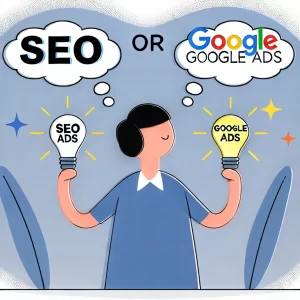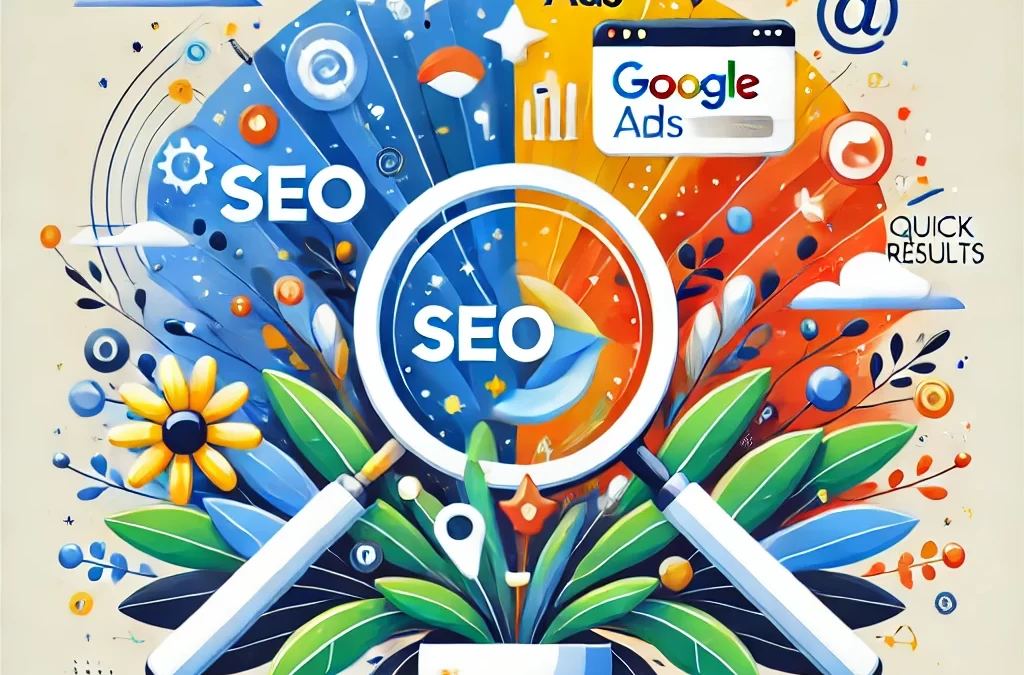In the world of digital marketing, businesses often find themselves at a crossroads, deciding whether to invest in SEO (Search Engine Optimization) or Google Ads. Some choose one over the other, while others try to dabble in both without fully understanding their potential when combined. What if I told you that SEO and Google Ads are not rivals but rather the perfect marketing duo? Like peanut butter and jelly, Batman and Robin, or Netflix and a cozy blanket, SEO and Google Ads can work together to deliver superior results for your business.
In this post, we’ll explore why combining SEO and Google Ads is a powerful strategy, how they complement each other, and how you can harness their combined strength to dominate the digital landscape.
1. The Dynamic Duo: Understanding the Basics
Before diving into the synergy between SEO and Google Ads, let’s take a quick refresher on what each one entails.
SEO (Search Engine Optimization):
SEO is the process of optimizing your website and content to rank higher in organic search results on search engines like Google. It involves a variety of strategies, including keyword research, on-page optimization, content creation, link building, and technical SEO. The goal of SEO is to increase the visibility of your website, drive more organic traffic, and improve your site’s authority over time.
Google Ads (formerly known as Google AdWords):
Google Ads is a paid advertising platform where businesses bid on keywords to have their ads displayed at the top of Google’s search results pages. Unlike organic search results, Google Ads placements are labeled as “sponsored” and appear above the organic listings. Google Ads allows businesses to target specific keywords, demographics, and geographic areas, making it a powerful tool for driving immediate traffic and conversions.

2. Why Choose When You Can Have Both?
Many businesses view SEO and Google Ads as mutually exclusive options, assuming they must choose one or the other based on budget or strategy. However, this couldn’t be further from the truth. When used together, SEO and Google Ads can amplify each other’s strengths, leading to better overall performance and a more comprehensive digital marketing strategy.
Here’s why:
A. Instant vs. Long-Term Results:
One of the biggest differences between SEO and Google Ads is the timeline for results. SEO is a long-term strategy; it takes time to build authority, climb the search rankings, and see a significant increase in organic traffic. On the other hand, Google Ads can deliver instant results. You can launch a campaign and start seeing traffic within minutes. By using both, you get the best of both worlds—quick wins from Google Ads and sustainable growth from SEO.
B. Enhanced Visibility:
When your website appears in both the paid ads section and organic search results, your visibility on the search engine results page (SERP) skyrockets. This dual presence not only increases the chances of getting clicks but also reinforces your brand’s authority and trustworthiness. Users are more likely to perceive your business as a leader in your industry when they see you dominating both paid and organic search results.
C. Keyword Insights:
Google Ads provides valuable data on which keywords are driving traffic and conversions. You can use this data to inform your SEO strategy, focusing on high-performing keywords that you know will yield results. Conversely, your SEO efforts can uncover long-tail keywords and phrases that might not be immediately apparent but have high potential for Google Ads campaigns. This cross-pollination of data makes both strategies more effective.
3. Complementary Strengths: How SEO and Google Ads Work Together
Now that we understand the individual benefits of SEO and Google Ads, let’s explore how they complement each other in practice.
A. Testing and Optimization:
Google Ads allows you to test different ad copy, headlines, and calls to action (CTAs) quickly. You can use these insights to optimize your SEO content. For example, if a particular headline in your Google Ads campaign is driving a high click-through rate (CTR), consider incorporating similar phrasing into your SEO titles and meta descriptions. This data-driven approach ensures that your SEO content is aligned with what resonates with your audience.
B. Brand Awareness and Remarketing:
While SEO is excellent for capturing users actively searching for your products or services, Google Ads can help you reach potential customers who might not yet be aware of your brand. Display ads, video ads on YouTube, and remarketing campaigns are powerful tools to build brand awareness and keep your business top-of-mind. Once these users are familiar with your brand, they are more likely to click on your organic search results, boosting your SEO performance.
C. Coverage Across the Buyer’s Journey:
The buyer’s journey consists of several stages—awareness, consideration, and decision. SEO is particularly effective in the awareness and consideration stages, where users are researching and comparing options. Google Ads, especially through search ads, can capture users at the decision stage, driving them to take action. By aligning your SEO and Google Ads strategies, you can ensure that your business is present at every stage of the buyer’s journey, guiding users from discovery to conversion.
4. Maximizing ROI: The Power of Integration
The real magic happens when you integrate SEO and Google Ads into a cohesive digital marketing strategy. Here’s how you can maximize your return on investment (ROI) by leveraging the strengths of both:
A. Coordinated Campaigns:
Run coordinated SEO and Google Ads campaigns around the same keywords or themes. For example, if you’re promoting a new product, optimize your website content for relevant SEO keywords while simultaneously running Google Ads targeting those same keywords. This coordinated approach ensures that you capture traffic from both organic and paid channels.
B. Budget Allocation:
Use Google Ads to supplement your SEO efforts in competitive niches where ranking organically may be challenging. Conversely, in areas where your SEO is strong, you can reduce your Google Ads spend and allocate the budget to other high-priority areas. This flexibility allows you to optimize your budget for maximum impact.
C. Continuous Learning and Improvement:
Both SEO and Google Ads provide a wealth of data. Regularly review your performance metrics, identify trends, and make data-driven decisions to improve your campaigns. The insights gained from one strategy can often enhance the other, leading to a cycle of continuous learning and improvement.
In the battle of SEO vs. Google Ads, there’s no need to pick sides. When combined, these two digital marketing powerhouses can work together to drive incredible results for your business. By understanding their unique strengths and how they complement each other, you can create a holistic strategy that maximizes your visibility, attracts high-quality traffic, and ultimately, drives conversions. So, don’t settle for just one—embrace the synergy of SEO and Google Ads and watch your digital marketing efforts soar.
And remember, if you ever need help navigating this dynamic duo, UpShore Agency is here to guide you every step of the way. Let’s make your business the next digital marketing success story!

